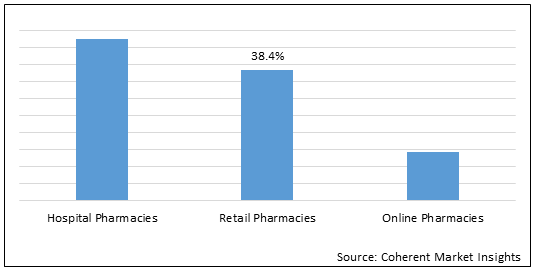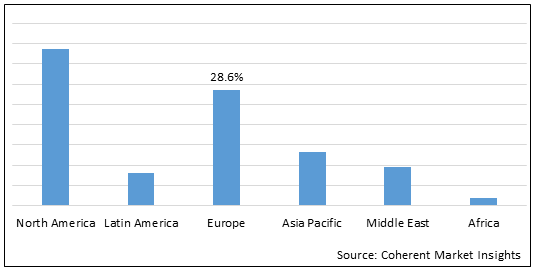Congenital Hyperinsulinism (CHI) is a condition that causes abnormal high level of insulin in an individual, insulin is the hormone that controls blood sugar level. There are different subdivisions of congenital hyperinsulinism which includes Diffuse KATP HI, exercised induced HI, focal KATP HI, GDH HI or HI/HA , GK HI, HNF4A/HNF1A HI, SCHAD. Excessive disregulation in insulin secretion from pancreatic beta cells may cause permanent brain damage and severe lifelong neurodisability. There are various subtypes and classification of congenital hyperinsulinism which includes Focal HI, Diffuse HI, K-ATP mutated HI, Transient HI, Persistent Hi, etc. There are certain immediate treatment goal to stabilize the level of insulin by certain methods like glucagon treatment, continuous infusions of glucagon, etc.
The global congenital hyperinsulinism treatment market is estimated to be valued at US$ 206.0 million in 2022 and is expected to exhibit a CAGR of 5.7% during the forecast period (2022-2030).
Figure 1. Global Congenital Hyperinsulinism Treatment Market Share (%), by Distribution Channel, 2022

To learn more about this report, Download Free Sample
Global Congenital Hyperinsulinism Treatment Market- Drivers
Growing awareness of congenital hyperinsulinism among the population is expected to drive the global congenital hyperinsulinism treatment global market. For instance, Congenital Hyperinsulinism International, a voluntary, non-profit organization focused on providing support such as disease diagnosis and disease management to the patient with CHI, and raising awareness among the people suffering from CHI. On 16 August 2022, the organization held a family conference where well renowned researchers, physicist, doctors, and patients of congenital hyperinsulinism with their family were featured. The conference were held to share the experience of patients and their family, to get the awareness about the disease and to know all the aspects of disease and its treatments.
Rise in research & development activities for the development of congenital hyperinsulinism drugs are expected to drive the market growth during the forecast period. For instance, in October 2021, Hanmi Pharm.Co., Ltd., a Pharmaceutical company initiated Phase 2 Clinical trial for HM15136 to evaluate the safety, tolerability, pharmacokinetics (PK), and efficacy of HM15136, a Glucagon analog chemically conjugated with constant region of human immunoglobulin via non-peptidyl flexible linker, used as add-on therapy in subjects with CHI with persistent hypoglycemia and the trial is expected to be completed on March 2025.
Congenital Hyperinsulinism Treatment Market Report Coverage
| Report Coverage | Details | ||
|---|---|---|---|
| Base Year: | 2021 | Market Size in 2022: | US$ 206.0 Mn |
| Historical Data for: | 2017 to 2020 | Forecast Period: | 2022 to 2030 |
| Forecast Period 2022 to 2030 CAGR: | 5.7% | 2030 Value Projection: | US$ 319.9 Mn |
| Geographies covered: |
|
||
| Segments covered: |
|
||
| Companies covered: |
Zealand Pharma A/S, Eli Lilly and Company, Xeris Pharmaceuticals, Inc., Rezolute, Inc., Hanmi Pharm.Co., Ltd., Fresenius Kabi AG, Eiger BioPharmaceuticals., |
||
| Growth Drivers: |
|
||
| Restraints & Challenges: |
|
||
Uncover macros and micros vetted on 75+ parameters: Get instant access to report
Figure 2.Global Congenital Hyperinsulinism Treatment Market Share (%), by Region, 2022

To learn more about this report, Download Free Sample
Global Congenital Hyperinsulinism Treatment Market– Impact of Coronavirus (COVID-19) Pandemic
Since the COVID-19 virus outbreak in December 2019, the disease has spread to over 100 countries across the globe and the World Health Organization had declared it a public health emergency on January 30, 2020.
COVID-19 can affect the economy in three main ways: by directly affecting production and demand of drugs, by creating disruptions in distribution channels, and through its financial impact on firms and financial markets. Due to nationwide lockdowns, several countries, such as China, India, Saudi Arabia, U.A.E., Egypt, and others, are facing problems with regards to the transportation of drugs from one place to another.
Moreover, clinical trials of endocrinal disease therapies and treatments has negative effect of COVID-19. For instance, in September, 2020, an article was published by Nepal Journal of Epidemiology suggested that the COVID-19 pandemic had negative impact on the clinical trial activities of endocrinal diseases such as congenital hyperinsulinism. There was decrease in new patient/subject enrollment which was due to mitigation efforts such as self-isolation and inaccessibility of health care facilities during pandemic with all aspects of clinical trials at various levels. The observed decrease in new subject enrollment in clinical trials was 64% in March 2019 to march 2020, 91 % in April 2019 to April 2020, and 89% in May 2019 to May 2020.
Global Congenital Hyperinsulinism Treatment Market: Key Developments
Glucagon, one of the primary medication of congenital hyperinsulinism shows promising results in treating congenital hyperinsulinism. For instance, in March 16, 2022, Xeris Pharmaceuticals, Inc., a biopharmaceutical company, develop a therapy for patients populations in endocrinology, a GVOKE kit (Glucagon Injection), containing liquid stable glucagon which is used to treat congenital hyperinsulinism. GVOKE was evaluated in a clinical trial in 31 pediatric patients with type 1 diabetes 100% (30/30) of pediatric patients had their glucose levels raise to safe levels.
This kit is indicated for the treatment of severe hypoglycemia in pediatric and adult patients with diabetes ages 2 years and above.
Global Congenital Hyperinsulinism Treatment Market: Restraint
The major factors that hinder growth of the global congenital hyperinsulinism treatment market include high cost of total annual treatment of first line of therapy. For instance, according to the data published by BioMedCentral Journal, an Orphanet Journal of rare diseases, in July 2018, the total annual cost of first line therapy is substantially high for congenital hyperinsulinism because of lack of response that is the cost of illness of CHI patients was US$ 13,144,870 annually and average cost per patient was US$ 2,083.19. Cost distribution was skewed among CHI patients, with 5.9% of patients (95 patients in their first year of life) contributing to 61.8% (U.S$ 2105491) of total costs which is high as compared to first line therapies.
Global Congenital Hyperinsulinism Treatment Market: Key Players
Major players operating in the global congenital hyperinsulinism treatment market include Zealand Pharma A/S, Eli Lilly and Company, Xeris Pharmaceuticals, Inc., Rezolute, Inc., Hanmi Pharm.Co., Ltd., Fresenius Kabi AG, Eiger BioPharmaceuticals., Crinetics Pharmaceuticals, Inc., AmideBio,LLC, Jolly Healthcare, e5 Pharma,LLC, Merck & Co.,Inc., Novo Nordisk A/S, Amphaster Pharmaceuticals,Inc., USV Private Limited, Teva Pharmaceutical Industries Ltd.
Share
Share
Missing comfort of reading report in your local language? Find your preferred language :
Transform your Strategy with Exclusive Trending Reports :
Frequently Asked Questions
Select a License Type
Joining thousands of companies around the world committed to making the Excellent Business Solutions.
View All Our Clients